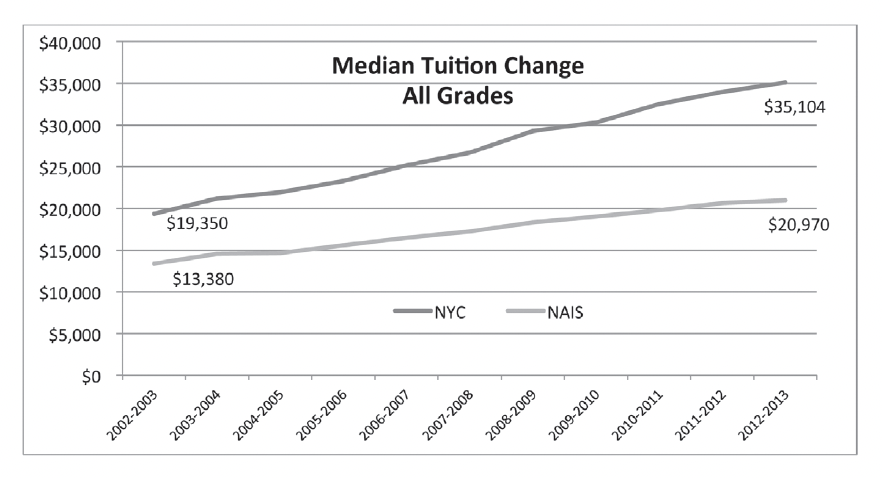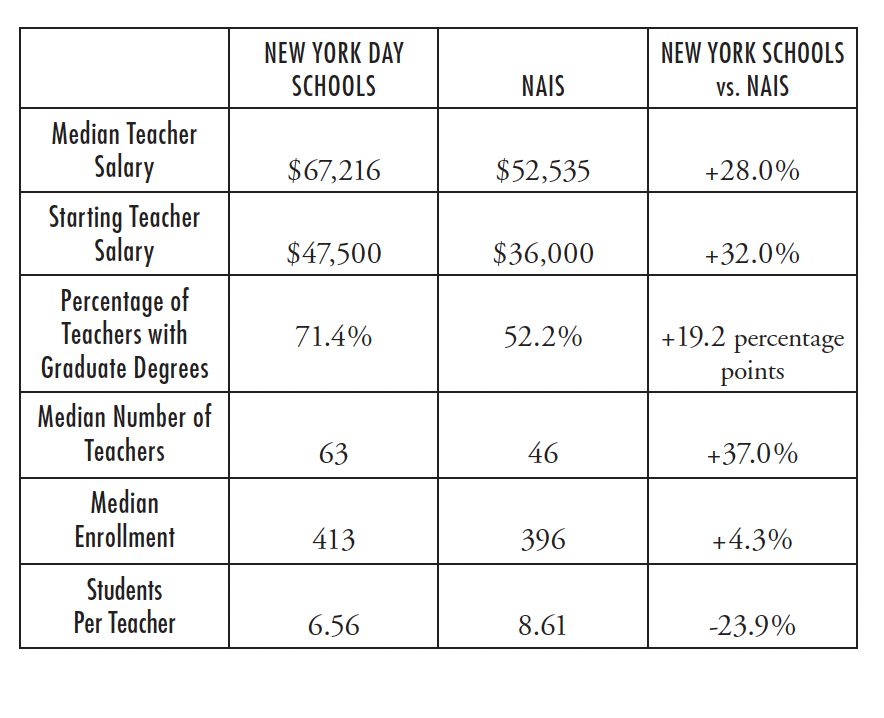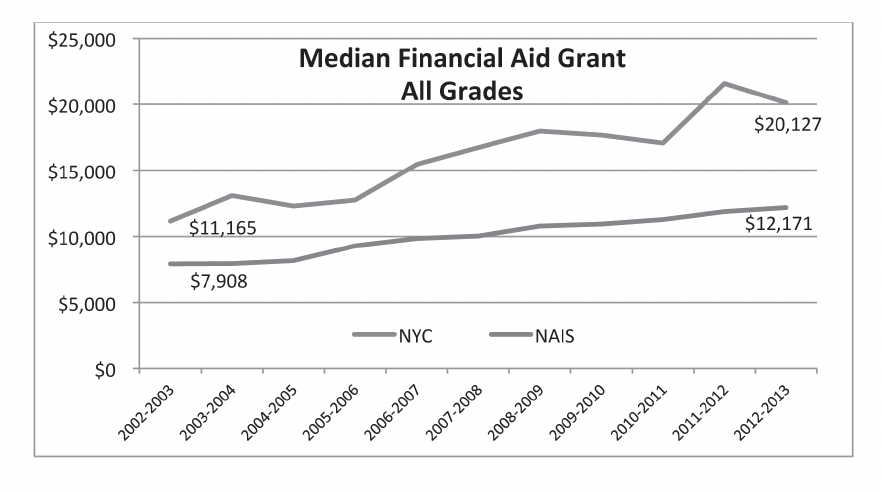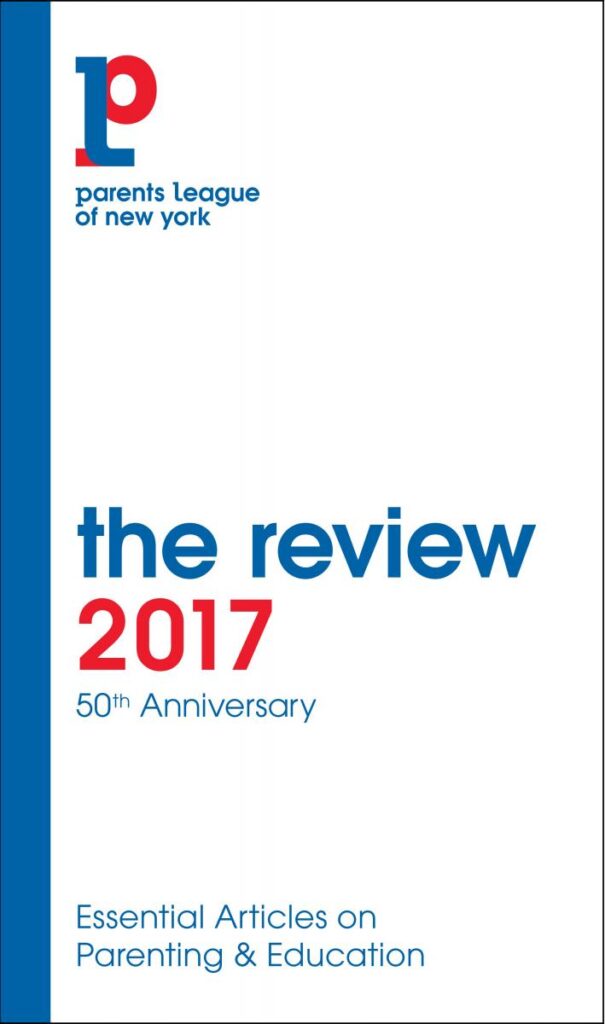Financial Aid: Making Independent School Affordable

There is no denying that recent pricing trends make the independent school choice seem less financially viable for many families. During the past decade, the tuition price tag has increased at significant rates. Data gathered by the National Association of Independent Schools (NAIS) show that the median tuition for all independent schools (of all types and grade levels) rose by nearly 50% during that time. For families in New York City’s day schools, the news is worse. In these schools, the median tuition has risen over 70%, from $21,189 in 2003-04 to $35,104 in 2012-13.
While New York City tuitions haven’t always been that much higher than that of other NAIS schools, the gap has been growing. Over the last ten years, while school tuitions nationally have trended up at 4.6% per year, New York City median tuition increases have averaged approximately 6.2% per year. In 2012-13, median tuition for New York City independent schools was 67% more expensive than the median tuition for NAIS independent schools at large. The chart below illustrates this widening gap in growth rates.

This trending threatens the affordability of the independent school option for all but the wealthiest families—assuming that even their incomes rise accordingly. Based on the School & Student Services By NAIS (SSS) methodology used to calculate a family’s ability to pay school cost, a family of four would need to earn nearly $210,000 to be able to pay the $35,104 median tuition for 2012-13 for one child. (Using the same formula, in 2002-03 the same family would have needed to earn about $145,500 to pay the $19,350 median tuition.) As tuition grows beyond families’ ability to keep pace with that growth, afford- ability becomes strained, with fewer families able to pay the full price.
Why are New York City Tuitions so High?
Most New Yorkers know and, to varying degrees, accept that the cost of living in the city is higher than the national average for nearly everything that is needed to support a comfortable lifestyle. In fact, based on Cost of Living Index data from the Council for Community and Economic Research, the cost of living for upper middle class, professional families in the boroughs of Manhattan, Queens and Brooklyn averages nearly 90% greater than the national average. So, as far as price differential is concerned, independent school tuition that is merely 70% greater than the national median could be seen as a bit of a value. Obviously schools don’t increase tuition just because there’s room to match the difference in costs of other goods and services in the city.
But why is the median tuition in New York City’s day schools so much greater than in independent schools overall? When looking at the difference in price points, it is imperative to consider the difference in cost points. The typical independent school has a relatively straightforward financial model, with a cost structure that is driven by personnel. Personnel costs (i.e., salaries and benefits) are the top expenditure in virtually every school’s budget. Here is where a considerable and important differential exists between a New York City school and the typical NAIS school: New York City’s independent schools have more, better-educated teachers living in a competitive and costly environment. And this is a key driver in much of the price differential. Consider these facts, drawn from the NAIS statistics database, for the 2012-13 academic year:

Even a cursory look at these kinds of comparative data suggests a few realities about the New York City independent school market:
- There is a “higher-quality premium” to pay for teachers. Teachers are significantly more likely to have graduate degrees than at other independent schools nationally.
- There is a “higher-touch premium” at play as well. Not only is the salary point for teachers higher, there are significantly more of them to pay. The median enrollment is just about 4% higher than the national median, but there are nearly 40% more teachers. This lower student/teacher ratio moves New York City schools closer to the valued individualized attention that makes independent schools attractive to families.
- There is a “higher-competition premium” to consider. To attract and retain high-quality, energetic and creative teachers in a crowded independent school market, New York City schools must be competitive with pay and other benefits. Not only must they compete with other schools—including great public and other types of private schools—but with other industries and careers such talented people could consider.
- There is a “higher-cost-of-living premium” to reconcile. As mentioned earlier, the cost-of-living in the city plays a part in relatively higher salaries. Compensation for teachers in the city has to allow them to be able to live in or close enough to the school communities where they work.
Of course, teacher salary and compensation are not the only pieces of the cost puzzle that drive the New York City tuition differential. The benefits of the independent school education typically go beyond access and exposure to high-quality teachers. Facilities costs, technology investment, and other factors also combine to make tuitions what they are. But the bottom line is still the bottom line. As much as families might comprehend and accept the factors that influence tuition pricing, they may still succumb to sticker shock. They may feel that—no matter the rationale or drivers—the $35,104 median price is beyond their capacity to pay.
New York City Schools Lead in Financial Aid
This is where school vision and leadership steps in. One of the primary reasons schools invest heavily in need-based financial aid programs is to keep costs more affordable for families who do not have the means to pay the full price, even though their child has the potential to thrive in the school community. Depending on the school, there may be other reasons for offering financial aid, with building socio-economic diversity or recognizing and rewarding special talents or contributions among them.
New York City’s independent schools lead the way in financial aid investment. Consider that in 2012-13, the median dollars spent in need-based financial aid among all NAIS schools was about $1.13 million per school. For New York City day schools, the median was $1.91 million per school, almost 70% greater. These dollars went to about 23% of enrolled students, about the same rate as NAIS schools overall, with a median grant award of $20,127 per recipient, also about 65% greater than the NAIS overall median need- based aid grant ($12,171). The chart below shows a trajectory of change in financial aid grants similar to the change in tuition price shown earlier.

Independent schools have endeavored to match tuition increases with increased financial aid grants as much as possible. In fact, in 2012-13, the median financial aid grant typically covered 57.3% of the median New York City day school tuition—almost exactly the amount (57.8%) covered by the median subsidy granted in 2002-03. However, back then only 18.2% of enrolled students received financial aid grants, compared to 23% in 2012- 13. By extending financial aid to offset increasing tuitions for a larger proportion of families, New York City independent schools saw the median total financial aid spending jump from about $860,000 per school in 2002-03 to the $1.19 million spent today (a 38.4% increase in investment). Of course, according to NAIS statistics, many schools spend much more, with some awarding as much as $8 million to $10 million.
The Financial Aid Application
Sticker shock should never dissuade a family from considering an independent school option. But tuition aid, provided on the basis of financial need, is driven by the premise that the primary responsibility to pay tuition falls to parents. The process is based on the demonstrated ability to pay tuition. “Demonstrated” means a family must show its ability to pay tuition by completing applications, submitting tax forms, and providing other information that schools will require. This allows schools to assess the resources that a family should reasonably be able to devote towards school costs. The process has low tolerance for unwillingness to pay; for virtually all families, some degree of sacrifice and participation is expected.
For most schools, a basic financial aid application consists of a standard form such as the SSS Parents’ Financial Statement, a copy of the family’s most recently completed IRS tax return, and copies of W-2 statement(s). Since deadlines for financial aid applications typically fall before tax return deadlines, many schools will accept the prior year’s tax forms as a guide if the current year’s forms are not yet completed. Families applying to more than one school must ask each school for its specific document requirements and filing deadlines, as they may be slightly different from one school to the next. Many New York City schools adhere to the application completion and notification guidelines established by the Independent Schools Admissions Association of Greater New York (ISAAGNY), which are driven by a mid-January deadline for submitting the financial aid application.
With a family’s completed application in hand, schools are able to determine ability to pay tuition and other expenses from the resources at a family’s disposal. The application is designed to take a snapshot of each family’s current financial strength, obligations and any potential external sources of support available. The main factors at play include all sources of current income (what you make or earn); the value of any assets such as real estate, checking/savings accounts, and investments (what you own); major debts the family is responsible to pay (what you owe); the size of the family in the household (who you support); and the number of children in tuition-charging schools in the year (other tuitions for which you are responsible).
The information on a completed Parents’ Financial Statement (or similar form) is assessed using a formula designed to estimate how much you are able to contribute. This “estimated family contribution” is forwarded to the financial aid professionals at the schools your family selects. The administrator will review the estimate against any additional information or documents (such as tax forms) to make an award decision. This decision is usually shared with a larger financial aid committee, typically consisting of three or four key administrators, to make sure that the decision itself is sound, fair and comparable with aid decisions made for other families in the pool. This approach ensures consistency and reflects that the final decisions are made by the school as an institution and not solely by a single person.
Who Receives Financial Aid?
Who qualifies for aid, as a result of balancing all of these factors and inputs, can vary quite a bit. There is no real, clear picture of the family that should apply or the family that shouldn’t. Since the process is designed to first assess what a family can pay, it’s possible to be eligible for aid at one school but not at another. For example, if the process yields that a family can pay $20,000 towards tuition, the student would not be eligible for aid at a $15,000 school because ability to pay exceeds the price, but eligible for a sizeable $15,000 grant at a $35,000 school. And, though there are no strict income cutoffs for determining eligibility, the “Two Comma Rule” applies: if reporting total income requires two commas, a family is probably not going to be eligible for aid.
It is noteworthy that a family could show eligibility for a need-based grant but still not receive one, or might only receive a portion of the full financial need it demonstrates. The most common reason for this is that schools have limited funding and cannot always meet the full need of every student that is deemed eligible. In the face of limited funding, many schools prioritize where they can and cannot meet need based on their enrollment goals or other considerations. For example, many schools that have grades K-12 do not provide financial aid for Kindergarten through fifth grade, but will provide aid for middle or high school grades.
Another reality driven by the inability to fully fund all families demonstrating need is the consideration that schools may be “need-aware” in the admissions process. Though most schools are “need-blind” when making admissions decisions (that is, the admissions decision is determined without regard to financial aid eligibility), some schools do adopt a “need-aware” approach to admissions. It’s important to note that a school can be “need-blind” but still not be able to meet a student’s demonstrated need. It usually simply means that the decision to admit is made before the determination of how much aid can be granted.
In a “need-aware” stance, on the other hand, the determination of how much aid can be granted may play a part in the decision to admit a student. The primary rationale is that a school may prefer not to offer admission if it is unable to meet the financial need of a family, thereby preventing the family from the untenable position of weighing an unrealistic choice to enroll.
It’s difficult for families to ascertain whether demonstrating financial need, or even applying for financial aid, will affect a child’s admission status. The only way to know a school’s “need-blind” or “need-aware” approach is to ask the school’s admission director, “Is your school need-blind in its admission decisions?” or “In what ways might applying for financial aid be a factor in the admission decision?”
Even if the school considers financial need as a factor in admissions decisions, it shouldn’t deter a family who truly needs aid from applying for it. Parents who apply for aid only after they’ve heard if their child is admitted are very likely to miss the school’s financial aid deadlines (and funding availability) and can be left without an aid offer as a result, even if the family is eligible for it.
Most schools do not give outright scholarships for considerations or attributes such as athletic abilities, special talents, race or ethnicity (NAIS data show that fewer than 2.5% of all financial aid dollars awarded in 2012-13 were based on factors other than financial need). However, these factors could come into play at some schools and situations when allocating need-based aid. A common example of this is in the case of a financial aid “wait pool” (admitted students who showed need but did not receive aid due to lack of funds). If families decline their financial aid offer (usually because they decide to go to another school), the school might reallocate those funds to students in the financial aid wait pool. Selecting who gets funded first from the pool could be based on factors that best match the school’s enrollment goals (e.g., a girl might get funded before a boy if that helps the school achieve better gender balance) or financial goals (e.g., using $10,000 to fund two students who each need $5,000 rather than one student who needs the full $10,000).
Yes, independent school tuition, especially in New York, is expensive. Given what drives tuition pricing at many schools, however, there are few things for which the phrase “you get what you pay for” can be truer than investing in, or sacrificing for, a quality education. Financial aid is designed to bring that education within greater reach.
Mark Mitchell is Vice President, School & Student Services By NAIS (National Association of Independent Schools).
This article first appeared in the 2014 Edition of Parents League Review. ©2017 Parents League of New York. Get the current edition of the Parents League Review free here with a family membership. Or purchase it directly here.












